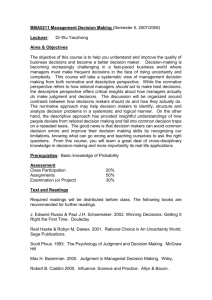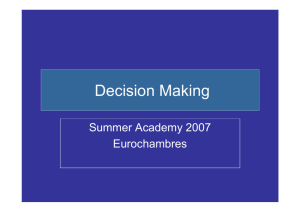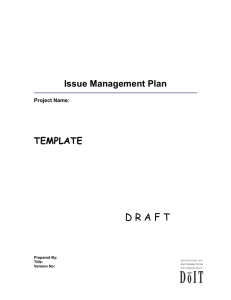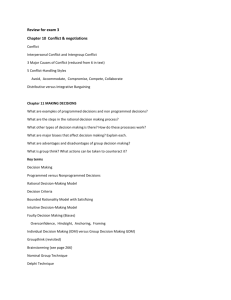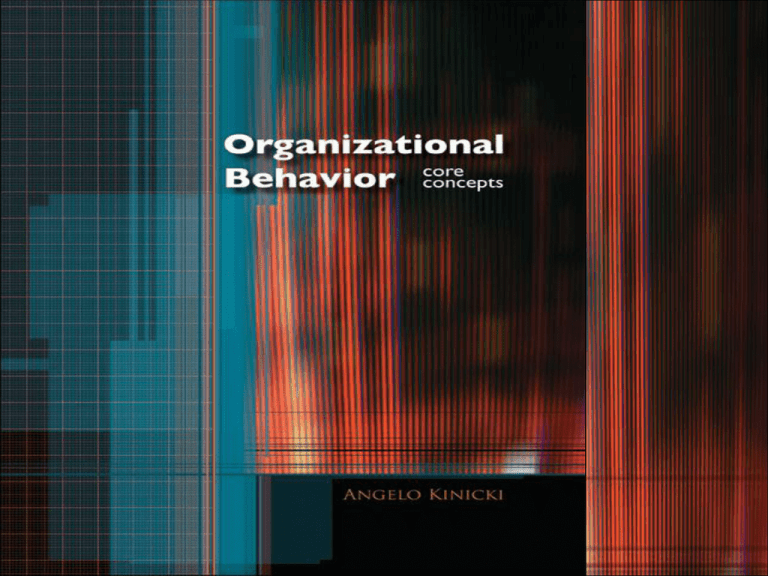
Organizational Behavior
7
core concepts
Decision Making: How
Individuals and Groups
Arrive at Decisions
7-2
McGraw-Hill/Irwin
Organizational Behavior, Core Concepts
Copyright © 2008 by the McGraw-Hill Companies, Inc. All rights reserved.
Learning Objectives
• Compare the rational model of decision
making with Simon’s normative model.
• Discuss knowledge management and
ways that companies increase
knowledge sharing.
• Explain the model of decision-making
styles and the stages of the creative
process.
7-3
Learning Objectives
• Summarize pros and cons of involving
groups in the decision-making process.
• Explain how participative management
affects performance.
• Describe techniques used to improve the
quality of group decisions
7-4
Models of Decision Making
• Decision making
– identifying and choosing solutions that lead
to a desired result
7-5
Models of Decision Making
• The Rational Model
– logical four-step approach to decision
making.
7-6
The Rational Model
1.
2.
3.
4.
7-7
Identifying the problem
Generating alternative solutions
Selecting a solution
Implementing and evaluating the
solution
Rational Model
• Identifying the Problem
– Problem – exists when the actual situation
and the desired situation differ
• Generating Solutions
– For routine decisions alternatives are readily
available through decision rules
7-8
Rational Model
• Selecting a Solution
– Want to maximize the expected utility of an
outcome
– People vary in their preferences for safety or
risk
– Ethics should be considered
7-9
Rational Model
• Selecting a Solution
– Evaluating alternatives assume they can be
judged according to some criteria
– Assumes valid criteria exists
– Each alternative can be compared to these
criteria
– Decision maker actually uses the criteria
7-10
Rational Model
• Implementing and Evaluating the
Solution
– After solution is implemented, the evaluation
phase is used to evaluate its effectiveness
– Optimizing – choosing the best possible
solution
7-11
Simon’s Normative Model
Decision making is characterized by:
1. Limited information processing
2. Use of judgmental heuristics
3. Satisficing
7-12
Simon’s Normative Model
• Bounded rationality
– constraints that restrict decision making
7-13
Simon’s Normative Model
Limited Information Processing
• Tendency to acquire manageable rather
than optimal amounts of information
• Difficult for managers to identify all
possible alternative solutions
7-14
Question?
What is a rule of thumb that people use to
reduce information processing
demands?
A. Decision maker
B. Judgmental heuristics
C. Judgmental verdict
D. Decision conclusion
7-15
Simon’s Normative Model
• Judgmental heuristics
– rules of thumb or shortcuts that people use
to reduce information processing demands.
7-16
Simon’s Normative Model
• Availability heuristic
– tendency to base decisions on information
readily available in memory.
• Representativeness heuristic
– tendency to assess the likelihood of an
event occurring based on impressions about
similar occurrences.
7-17
Simon’s Normative Model
• Satisficing
– choosing a solution that meets a minimum
standard
7-18
Dynamics of Decision Making
• Knowledge management
– implementing systems and practices that
increase the sharing of knowledge and
information throughout an organization
7-19
Forms of Knowledge
• Tacit knowledge
– information gained through experience that
is difficult to express and formalize.
• Explicit knowledge
– information that can be easily put into words
and shared with others.
7-20
General Decision Making Styles
• Decision making styles
– combination of how individuals perceive and
respond to information
7-21
General Decision Making Styles
• Value orientation
– reflects the extent to which an individual
focuses on either task and technical
concerns or people and social concerns
when making decisions
• Tolerance for ambiguity
– extent to which a person has a high need for
structure or control in his life
7-22
Decision Making Styles
7-23
Figure 7-1
Escalation of Commitment
• Escalation of
commitment
– sticking to an
ineffective course
of action too long
7-24
Escalation of Commitment
Psychological and Social Determinants
1. Tend to bias facts so that they support
previous decisions
2. Take more risks when a decision is
stated in negative terms
3. Get too ego-involved with the project
7-25
Escalation of Commitment
Organizational Determinants
• Breakdowns in communication
• Workplace politics
• Organizational inertia
7-26
Escalation of Commitment
Project Characteristics
• Tendency to attribute setbacks to
temporary causes that are correctable
with additional expenditures
7-27
Escalation of Commitment
Contextual determinants
• Culture of the decision makers
• Political climate of the escalation
situation
7-28
Recommendations To Reduce
Escalation of Commitment
• Set minimum targets for performance,
and have decision makers compare their
performance with these targets.
• Have different individuals make the initial
and subsequent decisions about a
project.
• Encourage decision makers to become
less ego-involved with a project.
7-29
Recommendations To Reduce
Escalation of Commitment
• Provide more frequent feedback about
project completion and costs.
• Reduce the risk or penalties of failure.
• Make decision makers aware of the costs
of persistence.
7-30
Question?
What is the process of using imagination to
develop a new process?
A. Originality
B. Innovation
C. Creativity
D. Resourcefulness
7-31
Creativity
• Creativity
– process of using intelligence, imagination,
and skill to develop a new or novel product,
object, process, or thought
7-32
Stages of the Creative Process
•
•
•
•
•
7-33
Preparation
Concentration
Incubation
Illumination
Verification
Group Involvement
• Minority dissent
– extent to which group members feel
comfortable disagreeing with other group
members, and the
extent to which group
members participate
in decision making
7-34
Advantages and Disadvantages of
Group-Aided Decision Making
7-35
Participative Management
• Participative Management
– involving employees in various forms of
decision making
• Setting goals
• Making decisions
• Solving problems
• Making changes in the organization
7-36
Group Problem Solving
Techniques
• Consensus
– presenting opinions and gaining agreement
to support a decision
• Brainstorming
– process to generate a quantity of ideas
7-37
Rules for Brainstorming
1.
2.
3.
4.
5.
6.
7.
7-38
Defer judgment
Build on the ideas of others
Encourage wild ideas
Go for quantity over quality
Be visual
Stay focused on the topic
One conversation at a time
Group Problem Solving
Techniques
• Nominal Group Technique
– process to generate ideas and evaluate
solutions.
• Delphi technique
– process to generate ideas from physically
dispersed experts
7-39
Group Problem Solving
Techniques
• Computer-aided decision making
– reduces consensus roadblocks while
collecting more information in a shorter
period of time
7-40
Computer-aided Decision Making
• Chauffeur-driven systems
– ask participants to answer predetermined
questions on electronic keypads
• Group-driven meetings
– conducted in special facilities equipped with
individual workstations that are networked to
each other
7-41


